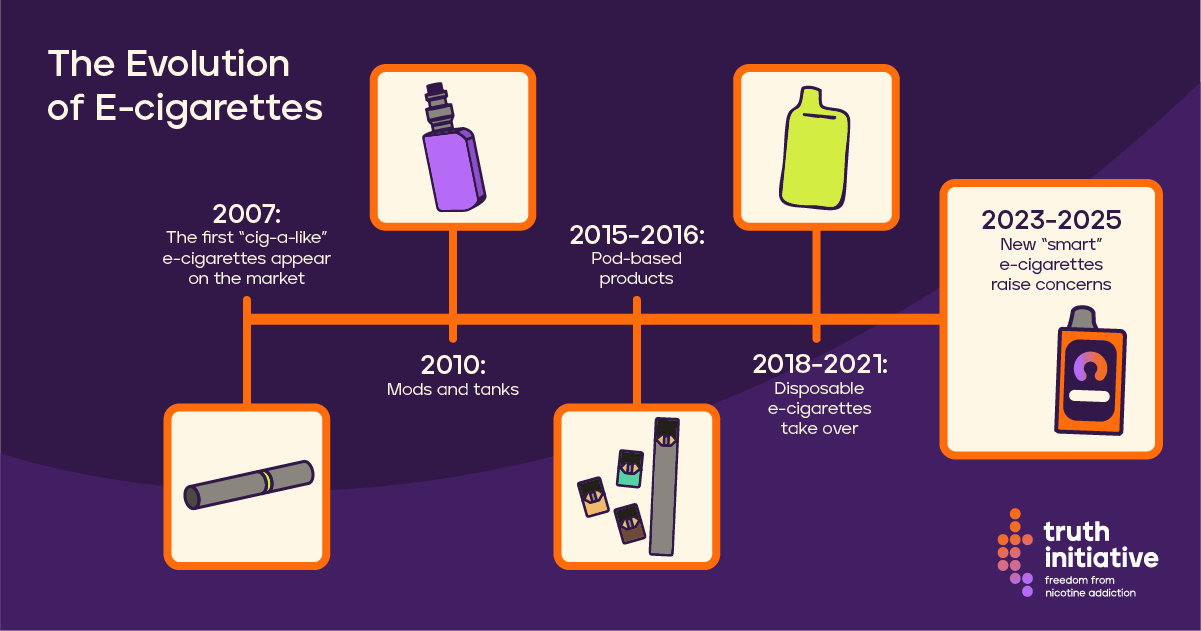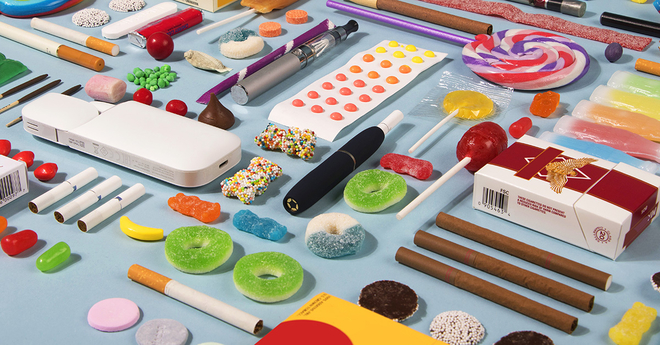How have e-cigarettes changed over time?
The e-cigarette market is constantly evolving and adapting to keep existing customers and attract new users. E-cigarette devices have changed drastically since they were introduced in 2007, and have become bigger, stronger, and cheaper over time.
Today, disposable e-cigarettes dominate the market, with many brands offering a range of youth-appealing flavors. Disposable e-cigarettes saw a huge rise in popularity after they were exempted from federal restrictions in 2020 that removed flavored pod-based e-cigarettes from the market but did not account for disposable products. By 2022, disposable e-cigarettes in the U.S. nearly tripled in nicotine strength, quintupled in e-liquid capacity, and dropped in price by nearly 70%. Furthermore, most of these products are on the market illegally, and are not regulated by the Food and Drug Administration (FDA).
Although youth e-cigarette use has gone down – from 2.13 million in 2023 to 1.63 million in 2024 – more than a quarter of young current e-cigarette users use them daily, and nearly 40% of current users report frequent use (at least 20 of the last 30 days). As e-cigarettes continue to grow in nicotine concentration and decrease in price, policies are needed to prevent youth initiation and address illegal e-cigarette sales.
For people quitting nicotine, Truth Initiative has partnered with Mayo Clinic to develop EX Program, a free digital quitting program that can increase the odds of quitting by up to 40%. EX Program helps people of all ages quit any tobacco or nicotine product with personalized quit plans, advice and tips from Mayo Clinic, and the largest online community of quitters.

2007: The first “Cig-a-like" e-cigarettes appear on the market
What did the first vape look like?
Cig-a-likes, or first-generation e-cigarettes, mimicked the design of traditional cigarettes and came in both disposable and reusable varieties. They were largely marketed to current smokers and promised users more freedom and fewer negative health impacts.
2010: Mods and tanks offer new options for experienced users
When were the large tank vapes popular?
Mods and tanks had a larger capacity for nicotine e-liquid and were marketed toward experienced e-cigarette users. Mods and tanks offered the ability to control heat and temperature, allowing users to create huge clouds and perform tricks.
2015-2016: Pod-based products make e-cigarettes more accessible to a wider audience
When was JUUL the most popular vape?
Pod-based products such as JUUL offered a sleek and user-friendly experience in comparison to boxy mods and tanks that required re-filling with nicotine e-liquid, often sold separately. Nicotine salts were also introduced in pod-based products to make the e-cigarette liquid more palatable. High-tech designs, youth-friendly marketing, and sweet flavors made these products highly appealing to young people.
2018-2021: Disposable e-cigarettes take over
Why did we see an increase in use of disposable vapes?
Disposable e-cigarettes saw a huge rise in popularity after they were exempted from federal restrictions in 2020 that removed flavored pod-based e-cigarettes from the market. This period also marks the height of youth e-cigarette use: in 2019, over five million youth reported current e-cigarette use. The rise of disposable e-cigarettes has raised environmental concerns, as well as questions about youth access, as these products are often low-cost and contain youth-appealing flavors.
Following the federal ban on pod-based products, many disposable products came on the market illegally – without authorization from the FDA. According to a Truth Initiative study, the overwhelming majority – more than 86% – of e-cigarettes on the market in March 2024 were illegal products.
2023-2025: Disposable re-chargeables and “smart” e-cigarettes raise concerns about youth use
The history of vaping
Rechargeable disposable devices contain large amounts of nicotine e-liquid, with batteries that can be recharged. These products are long-lasting and able to deliver nicotine in large amounts compared to previous products.
“Smart” e-cigarettes, some of which are also re-chargeable, contain high-tech features such as Bluetooth capability, high-definition screens, and speakers, with some versions including games such as Pac-Man and Tetris. These products are attractive to young people, are roughly the same price as regular e-cigarettes, and may couple nicotine addiction with gaming disorders.
What’s next?
What is the future of vaping?
Nicotine products, including e-cigarettes, will continue to evolve and adapt based on new technology, policies, and trends. Oral nicotine pouches have also grown in popularity and will continue to impact the nicotine product landscape.
Comprehensive policies, such as restrictions on sales of cheap and high-nicotine flavored e-cigarettes, are needed to prevent young people from accessing these products.
More in emerging tobacco products
Want support quitting? Join EX Program
By clicking JOIN, you agree to the Terms, Text Message Terms and Privacy Policy.
Msg&Data rates may apply; msgs are automated.


